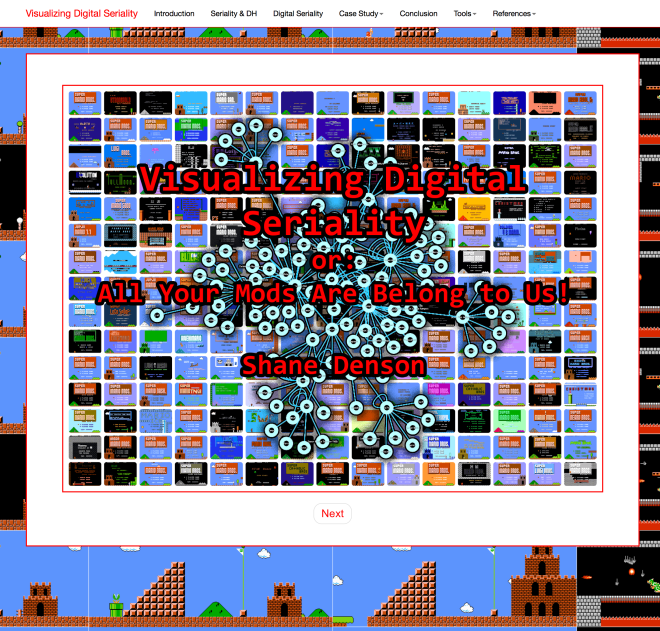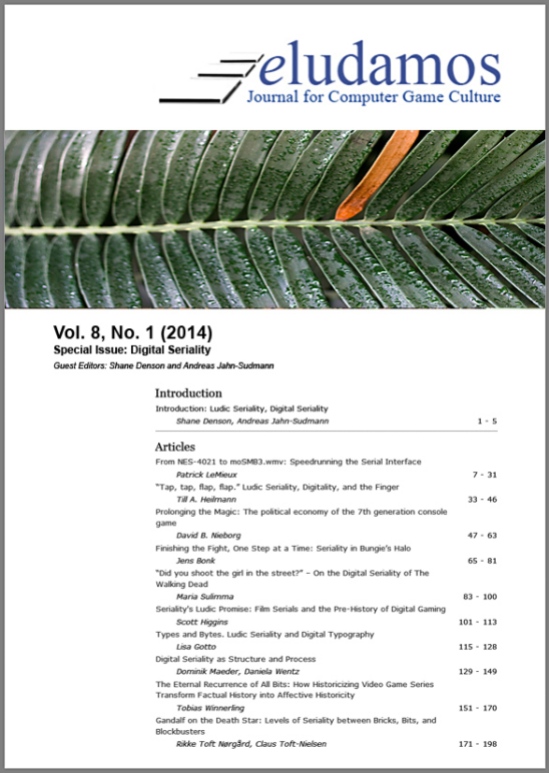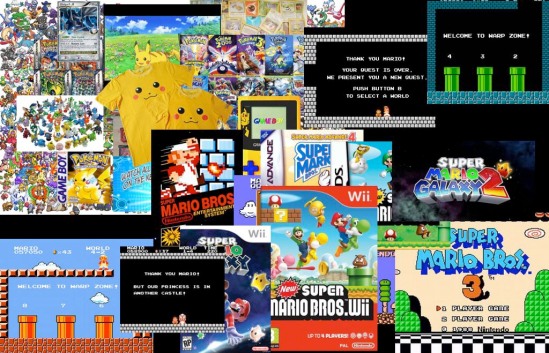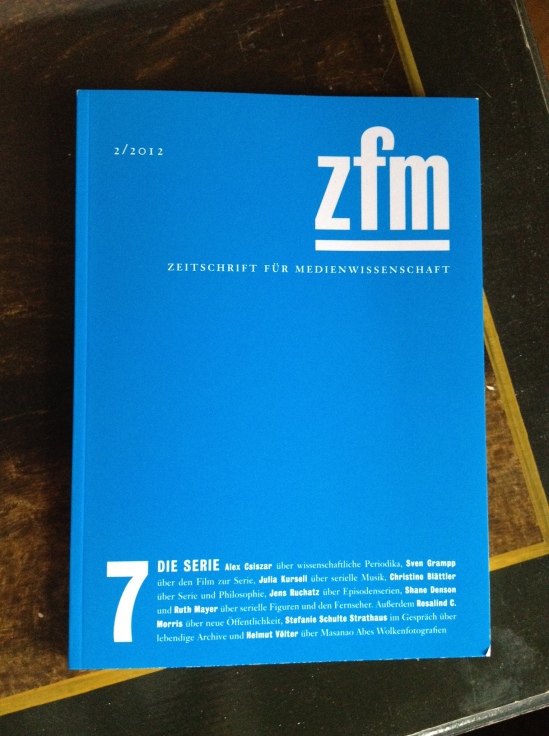I am excited to see my interactive piece, “Visualizing Digital Seriality, or: All Your Mods Are Belong to Us,” out now in the latest issue of Kairos: A Journal of Rhetoric, Technology, and Pedagogy. This is by far the most technically demanding piece of scholarship I have ever produced, and it underwent what is possibly the most rigorous peer-review process to which any of my published articles has ever been subject. If you’re interested in data visualization, distant reading techniques, network graphing, critical code studies, game studies, modding scenes, or Super Mario Bros. (and who doesn’t like Super Mario Bros.?), check it out!
Category: Journals
Out Now: Post-What? Post-When?
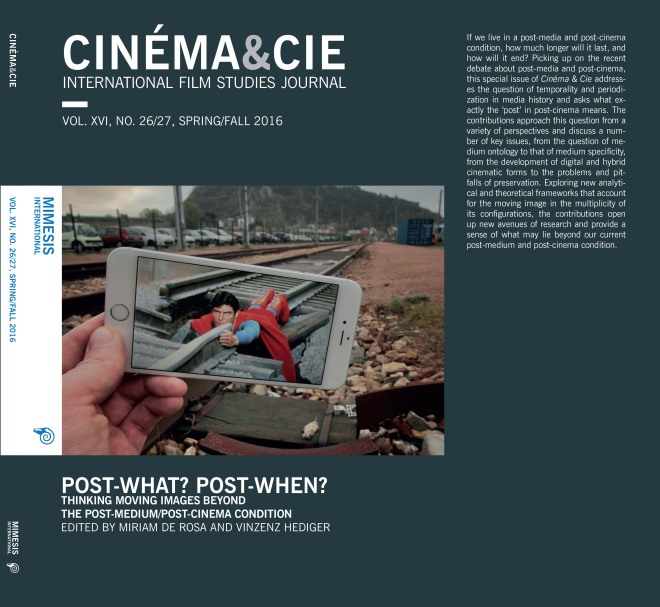
The new issue of Cinéma & Cie, edited by Miriam de Rosa and Vinzenz Hediger, is out now. The special issue, which goes to the heart of recent discussions of post-cinema, is provocatively titled “Post-What? Post-When?,” and it includes my own contribution, titled “Speculation, Transition, and the Passing of Post-Cinema” alongside pieces by Malcolm Turvey & Ted Nannicelli, Sabrina Negri, Rachel Schaff, Saige Walton, and Monica Dall’Asta. The contributions are framed by a “Conversation on the ‘Posts’ of Post-Media and Post-Cinema” by Miriam de Rosa & Vinzenz Hediger.
General description of the special issue:
If we live in a post-media and post-cinema condition, how much longer will it last, and how will it end? Picking up on the recent debate about post-media and post-cinema, this special issue of Cinéma & Cie addresses the question of temporality and periodization in media history and asks what exactly the ‘post’ in post-cinema means. The contributions approach this question from a variety of perspectives and discuss a number of key issues, from the question of medium ontology to that of medium specificity, from the development of digital and hybrid cinematic forms to the problems and pitfalls of preservation. Exploring new analytical and theoretical frameworks that account for the moving image in the multiplicity of its configurations, the contributions open up new avenues of research and provide a sense of what may lie beyond our current post-media and post-cinema condition.
Out Now: ETC Media 110
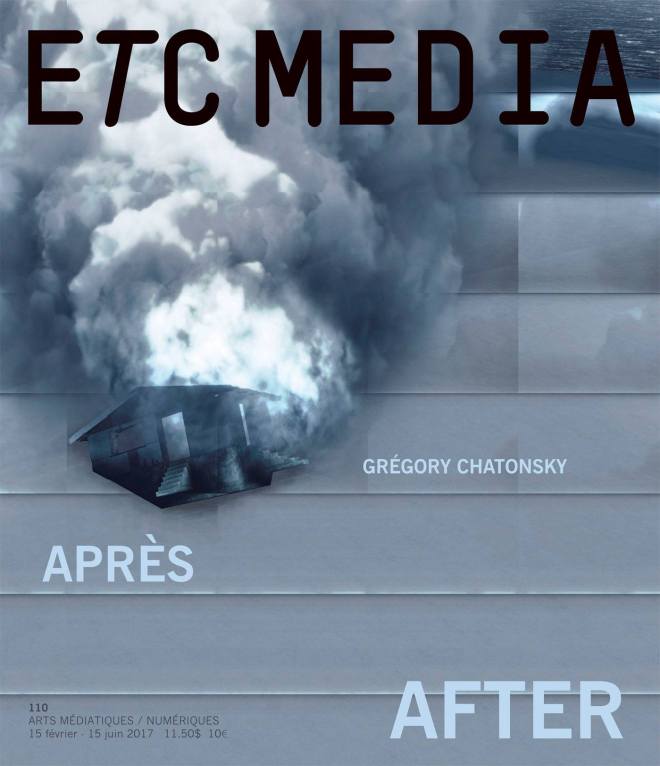
I am proud to have a piece on “Pre-Sponsive Gestures” and the work of French media artist Grégory Chatonsky included in the new issue of the Montreal-based ETC Media. Looks like a great issue, and happy to be in such good company!
CURRENT ISSUE // 110
GRÉGORY CHATONSKY: APRÈS LE RÉSEAU / AFTER THE NETWORKIssue 110 of ETC MEDIA is dedicated to Grégory Chatonsky, who has curated the form and content of this special issue. A Montreal resident for the last ten years, the artist is a pioneer of net art, founding Incident.net in 1994, and an unflagging explorer of the relationships between technology and anonymous existence. In this issue, the artist and a few other friends, artists, philosophers, art historians, and art critics reconsider the last two decades of experimentation, a time in which the world drastically changed through the widespread use of the Internet to reach a digital omnipresence that heralds a near extinction. Divided into 3 sections—“infinitude,” “hyperproduction,” “without ourselves”—ETC MEDIA becomes a platform for navigating in our era and gaining a better understanding of a future whose portents remain deeply ambivalent—promising and threatening all at once. Rather than being reduced to trendy notions often misunderstood by the contemporary art milieu, the concepts of post-digital, accelerationism, and speculative materialism constellate a world in the process of perishing and being born.
Collaborators
Grégory Chatonsky
Eve K. Tremblay
Pau Waelder
Bertrand Gervais and Arnaud Regnauld
Shane Denson
DeForrest Brown Jr.
Goliath Dyèvre
Pierre Cassou-Noguès
Erik Bordeleau
Nora N. Khan
Dylan Trigg
Pierre-Alexandre Fradet
Jussi Parikka
Postnaturalism reviewed in MEDIENwissenschaft
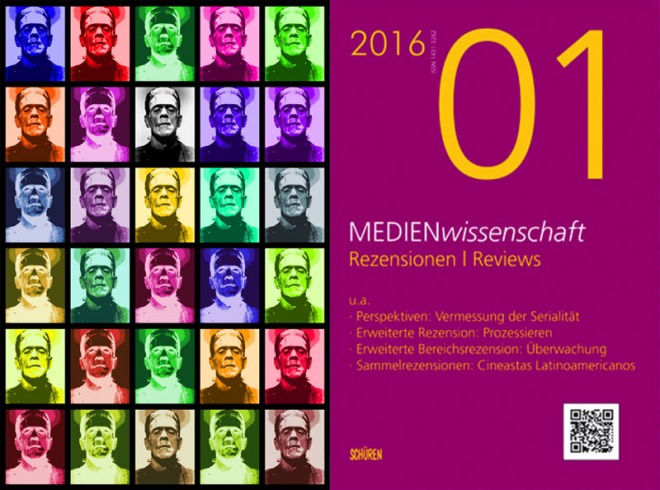
The latest issue of MEDIENwissenschaft: Rezensionen/Reviews includes a nice review of my book Postnaturalism: Frankenstein, Film, and the Anthropotechnical Interface.
For those of you who read German, you can find the entire text of the review, by Anya Heise-von der Lippe (Tübingen/Berlin), here. For everyone else, here is a (rough) translation of the reviewer’s summary statement:
“Postnaturalism offers a philosophical approach and an engagement with fundamental ontological and phenomenological questions of human and nonhuman materiality, which is indispensable especially for a post-postmodernity characterized by resource scarcity, climate change, and species extinctions, as well as the threat of a return to essentialist positions in politics and popular culture. Adapting a phrase from Bruno Latour, Denson counters the latter with a postnatural position: “We have never been natural” (24). Furthermore, Denson’s detailed examination — at the level of content, reception, and production — of Frankenstein adaptations is an asset for the analytical and production-aesthetic [produktionsästhetische] investigation of a central text (or modern myth) and its many adaptations in a wide range of text-critical disciplines: from media studies to literary to cultural studies.”
(Again, the translation is rough. Tweaks are more than welcome! Especially if you have suggestions for produktionsästhetisch or for making that first sentence more readable, drop me a line in the comments below…)
Finally, make sure you check out the entire issue of MEDIENwissenschaft, which is chock full of great stuff. Of particular interest to readers of this blog, among other things: the “Perspectives” section contains a longer piece on seriality and television series’ interrelations by Tanja Weber and Christian Junklewitz.
Check out the full contents of the issue here.
Out Now: [in]Transition 2.4
The latest issue of [in]Transition: Journal of Videographic Film & Moving Image Studies has just been published. This is a special issue featuring video essays that emerged out of the NEH workshop on videographic criticism that I attended last summer at Middlebury College, organized by Jason Mittell and Christian Keathley. In addition to my video essay “Sight and Sound Conspire: Monstrous Audio-Vision in James Whale’s Frankenstein (1931)” — with peer reviews by Steven Shaviro and Drew Morton — the special issue also contains great pieces by Allison de Fren, Patrick Keating, Jaap Kooijman, and Michael Talbott. Check it out!
SCMS 2015 Preliminary Schedule Online — #SCMS15
The preliminary schedule for the Society of Cinema and Media Studies 2015 conference in Montreal is now online (here). As I posted recently, I will be involved in two separate panels:
First, I will be chairing the panel on “Post-Cinema and/as Speculative Media Theory” (panel K7, Friday, March 27, 2015, 9:00-10:45am) — with presenters Steven Shaviro, Patricia Pisters, Adrian Ivakhiv, and Mark B. N. Hansen. You can find the complete panel description, as well as individual abstracts, here. Note also that all participants on this panel are contributors to the forthcoming Post-Cinema: Theorizing 21st-Century Film, which I am co-editing with Julia Leyda.
Second, I will be participating in a panel on “Digital Seriality” (panel Q20, Saturday, March 28, 2015, 3:00-4:45pm) — along with Andreas Jahn-Sudmann, Scott Higgins, Dominik Maeder, and Daniela Wentz. Panel description and abstracts can be found here. And, as with the other panel, this one too has a tie-in with a publication: all the participants on this panel were contributors to the special issue of Eludamos: Journal for Computer Game Culture that Andreas Jahn-Sudmann and I edited on the topic of “Digital Seriality.”
Out Now: Digital Seriality — Special Issue of Eludamos
The latest issue of Eludamos: Journal for Computer Game Culture, a special issue devoted to the topic of “Digital Seriality” — edited by yours truly, together with Andreas Jahn-Sudmann — is now out! Weighing in at 198 pages, this is one of the fattest issues yet of the open-access journal, and it’s jam-packed with great stuff like:
- Patrick LeMieux on the culture and technology of tool-assisted speedrunning
- Jens Bonk on the serial structure of Halo
- Scott Higgins on the ludic pre-history of gaming in serial films
- Lisa Gotto on ludic seriality and digital typography
- Tobias Winnerling on the serialization of history in “historical” games
- Till Heilmann on Flappy Bird and the seriality of digits
- David B. Nieborg on the political economy of blockbuster games
- Rikke Toft Nørgård and Claus Toft-Nielsen on LEGO as an environment for serial play
- Dominik Maeder and Daniela Wentz on serial interfaces and memes
- Maria Sulimma on cross-medium serialities in The Walking Dead!
So what are you waiting for? Do yourself a favor and check out this issue now!
CFP: Digital Seriality — Special Issue of Eludamos: Journal for Computer Game Culture
I am pleased to announce that my colleague Andreas Jahn-Sudmann and I will be co-editing a special issue of Eludamos: Journal for Computer Game Culture on the topic of “Digital Seriality.” Here, you’ll find the call for papers (alternatively, you can download a PDF version here). Please circulate widely!
Call for Papers: Digital Seriality
Special Issue of Eludamos: Journal for Computer Game Culture (2014)
Edited by Shane Denson & Andreas Jahn-SudmannAccording to German media theorist Jens Schröter, the analog/digital divide is the “key media-historical and media-theoretical distinction of the second half of the twentieth century” (Schröter 2004:9, our translation). And while this assessment is widely accepted as a relatively uncontroversial account of the most significant media transformation in recent history, the task of evaluating the distinction’s inherent epistemological problems is all the more fraught with difficulty (see Hagen 2002, Pias 2003, Schröter 2004). Be that as it may, since the 1990s at the latest, virtually any attempt to address the cultural and material specificity of contemporary media culture has inevitably entailed some sort of (implicit or explicit) evaluation of this key distinction’s historical significance, thus giving rise to characterizations of the analog/digital divide as caesura, upheaval, or even revolution (Glaubitz et al. 2011). Seen through the lens of such theoretical histories, the technical and especially visual media that shaped the nineteenth and twentieth centuries (photography, film, television) typically appear today as the objects of contemporary digitization processes, i.e. as visible manifestations (or remnants) of a historical transition from an analog (or industrial) to a digital era (Freyermuth and Gotto 2013). Conversely, despite its analog pre-history today’s digital computer has primarily been addressed as the medium of such digitization processes – or, in another famous account, as the end point of media history itself (Kittler 1986).
The case of digital games (as a software medium) is similar to that of the computer as a hardware medium: although the differences and similarities between digital games and older media were widely discussed in the context of the so-called narratology-versus-ludology debate (Eskelinen 2001; Juul 2001; Murray 1997, 2004; Ryan 2006), only marginal attention was paid in these debates to the media-historical significance of the analog/digital distinction itself. Moreover, many game scholars have tended to ontologize the computer game to a certain extent and to treat it as a central form or expression of digital culture, rather than tracing its complex historical emergence and its role in brokering the transition from analog to digital (significant exceptions like Pias 2002 notwithstanding). Other media-historiographical approaches, like Bolter and Grusin’s concept of remediation (1999), allow us to situate the digital game within a more capacious history of popular-technical media, but such accounts relate primarily to the representational rather than the operative level of the game, so that the digital game’s “ergodic” form (Aarseth 1999) remains largely unconsidered.
Against this background, we would like to suggest an alternative angle from which to situate and theorize the digital game as part of a larger media history (and a broader media ecology), an approach that attends to both the representational level of visible surfaces/interfaces and the operative level of code and algorithmic form: Our suggestion is to look at forms and processes of seriality/serialization as they manifest themselves in digital games and gaming cultures, and to focus on these phenomena as a means to understand both the continuities and the discontinuities that mark the transition from analog to digital media forms and our ludic engagements with them. Ultimately, we propose, the computer game simultaneously occupies a place in a long history of popular seriality (which stretches from pre-digital serial literature, film, radio, and television, to contemporary transmedia franchises) while it also instantiates novel forms of a specifically digital type of seriality (cf. Denson and Jahn-Sudmann 2013). By grappling with the formal commensurabilities and differences that characterize digital games’ relations to pre-digital (and non-ludic) forms of medial seriality, we therefore hope to contribute also to a more nuanced account of the historical process (rather than event) of the analog/digital divide’s emergence.
Overall, seriality is a central and multifaceted but largely neglected dimension of popular computer and video games. Seriality is a factor not only in explicitly marked game series (with their sequels, prequels, remakes, and other types of continuation), but also within games themselves (e.g. in their formal-structural constitution as an iterative series of levels, worlds, or missions). Serial forms of variation and repetition also appear in the transmedial relations between games and other media (e.g. expansive serializations of narrative worlds across the media of comics, film, television, and games, etc.). Additionally, we can grasp the relevance of games as a paradigm example of digital seriality when we think of the ways in which the technical conditions of the digital challenge the temporal procedures and developmental logics of the analog era, e.g. because once successively appearing series installments are increasingly available for immediate, repeated, and non-linear forms of consumption. And while this media logic of the database (cf. Manovich 2001: 218) can be seen to transform all serial media forms in our current age of digitization and media convergence, a careful study of the interplay between real-time interaction and serialization in digital games promises to shed light on the larger media-aesthetic questions of the transition to a digital media environment. Finally, digital games are not only symptoms and expressions of this transition, but also agents in the larger networks through which it has been navigated and negotiated; serial forms, which inherently track the processes of temporal and historical change as they unfold over time, have been central to this media-cultural undertaking (for similar perspectives on seriality in a variety of media, cf. Beil et al. 2013, Denson and Mayer 2012, Jahn-Sudmann and Kelleter 2012, Kelleter 2012, Mayer 2013).
To better understand the cultural forms and affective dimensions of what we have called digital games’ serial interfacings and the collective serializations of digital gaming cultures (cf. Denson and Jahn-Sudmann 2013), and in order to make sense of the historical and formal relations of seriality to the emergence and negotiation of the analog/digital divide, we seek contributions for a special issue of Eludamos: Journal of Computer Game Culture on all aspects of game-related seriality from a wide variety of perspectives, including media-philosophical, media-archeological, and cultural-theoretical approaches, among others. We are especially interested in papers that address the relations between seriality, temporality, and digitality in their formal and affective dimensions.
Possible topics include, but are not limited to:
- Seriality as a conceptual framework for studying digital games
- Methodologies and theoretical frameworks for studying digital seriality
- The (im)materiality of digital seriality
- Digital serialities beyond games
- The production culture of digital seriality
- Intra-ludic seriality: add-ons, levels, game engines, etc.
- Inter-ludic seriality: sequels, prequels, remakes
- Para-ludic seriality: serialities across media boundaries
- Digital games and the limits of seriality
******************************************************************************
Paper proposals (comprising a 350-500 word abstract, 3-5 bibliographic sources, and a 100-word bio) should be sent via e-mail by March 1, 2014 to the editors:
- a.sudmann[at]fu-berlin.de
- shane.denson[at]engsem.uni-hannover.de
Papers will be due July 15, 2014 and will appear in the fall 2014 issue of Eludamos.
*******************************************************************************
References:
Aarseth, Espen. 1999. “Aporia and Epiphany in Doom and The Speaking Clock: The Temporality of Ergodic Art.” In Marie-Laure Ryan, ed. Cyberspace Textuality: Computer Technology and Literary Theory. Bloomington: Indiana University Press, 31–41.
Beil, Benjamin, Lorenz Engell, Jens Schröter, Daniela Wentz, and Herbert Schwaab. 2012. “Die Serie. Einleitung in den Schwerpunkt.” Zeitschrift Für Medienwissenschaft 2 (7): 10–16.
Bolter, J. David, and Richard A, Grusin. 1999. Remediation: Understanding New Media. Cambridge, Mass.: MIT Press.
Denson, Shane, and Andreas Jahn-Sudmann. “Digital Seriality: On the Serial Aesthetics and Practice of Digital Games.” Eludamos. Journal for Computer Game Culture 1 (7): 1-32. http://www.eludamos.org/index.php/eludamos/article/view/vol7no1-1/7-1-1-html.
Denson, Shane, and Ruth Mayer. 2012. “Grenzgänger: Serielle Figuren im Medienwechsel.” In Frank Kelleter, ed. Populäre Serialität: Narration – Evolution – Distinktion. Zum seriellen Erzählen seit dem 19. Jahrhundert. Bielefeld: Transcript, 185-203.
Eskelinen, Markku. 2001. “The Gaming Situation” 1 (1). http://www.gamestudies.org/0101/eskelinen/.
Freyermuth, Gundolf S., and Lisa Gotto, eds. 2012. Bildwerte: Visualität in der digitalen Medienkultur. Bielefeld: Transcript.
Glaubitz, Nicola, Henning Groscurth, Katja Hoffmann, Jörgen Schäfer, Jens Schröter, Gregor Schwering, and Jochen Venus. 2011. Eine Theorie der Medienumbrüche. Vol. 185/186. Massenmedien und Kommunikation. Siegen: Universitätsverlag Siegen.
Hagen, Wolfgang. 2002. “Es gibt kein ‘digitales Bild’: Eine medienepistemologische Anmerkung.” In: Lorenz Engell, Bernhard Siegert, and Joseph Vogl, eds. Archiv für Mediengeschichte Vol. 2 – “Licht und Leitung.” München: Wilhelm Fink Verlag, 103–12.
Jahn-Sudmann, Andreas, and Frank Kelleter. “Die Dynamik Serieller Überbietung: Zeitgenössische Amerikanische Fernsehserien und das Konzept des Quality TV.” In Frank Kelleter, ed. Populäre Serialität: Narration – Evolution – Distinktion. Zum seriellen Erzählen seit dem 19. Jahrhundert. Bielefeld: Transcript, 205–24.
Juul, Jesper. 2001. “Games Telling Stories? – A Brief Note on Games and Narratives.” Game Studies 1 (1). http://www.gamestudies.org/0101/juul-gts/.
Kelleter, Frank, ed. 2012. Populäre Serialität: Narration – Evolution – Distinktion: Zum seriellen Erzählen seit dem 19. Jahrhundert. Bielefeld: Transcript.
Kittler, Friedrich A. 1986. Grammophon, Film, Typewriter. Berlin: Brinkmann & Bose.
Manovich, Lev. 2001. The Language of New Media. Cambridge, Mass.: MIT Press.
Mayer, Ruth. 2013. Serial Fu Manchu: The Chinese Supervillain and the Spread of Yellow Peril Ideology. Philadelphia: Temple University Press.
Murray, Janet H. 1997. Hamlet on the Holodeck: The Future of Narrative in Cyberspace. Cambridge: MIT Press.
Murray, Janet H. 2004. “From Game-Story to Cyberdrama.” In Noah Wardrip-Fruin and Pat Harrigan, eds. First Person: New Media as Story, Performance, and Game. Cambridge, MA: MIT Press, 2-10.
Pias, Claus. 2002. Computer Spiel Welten. Zürich, Berlin: Diaphanes.
Pias, Claus. 2003. “Das digitale Bild gibt es nicht. Über das (Nicht-)Wissen der Bilder und die informatische Illusion.” Zeitenblicke 2 (1). http://www.zeitenblicke.de/2003/01/pias/.
Ryan, Marie-Laure. 2006. Avatars of Story. Minneapolis: University of Minnesota Press.
Schröter, Jens. 2004. “Analog/Digital – Opposition oder Kontinuum?” In Jens Schröter and Alexander Böhnke, eds. Analog/Digital – Opposition oder Kontinuum? Beiträge zur Theorie und Geschichte einer Unterscheidung. Bielefeld: Transcript, 7–30.
Digital Seriality
Just in time for the holidays, a new issue of the open-access journal Eludamos: Journal for Computer Game Culture is now online. Among the articles in this issue is a piece that I co-authored with Andreas Jahn-Sudmann, called “Digital Seriality: On the Serial Aesthetics and Practice of Digital Games.” In this article we put forward some of the central ideas of our joint research project and provide illustrations of serial aesthetics and practices in games and game cultures. Here is the abstract for the paper:
In this paper we are concerned to outline a set of perspectives, methods, and theories with which to approach the seriality of digital games and game cultures – i.e. the aesthetic forms and cultural practices of game-related serialization, which we see unfolding against (and, in fact, as a privileged mediator of) the broader background of medial and socio-cultural transformations taking place in the wake of popular media culture’s digitalization. Seriality, we contend, is a central and multifaceted but largely neglected dimension of popular computer and video games. Seriality is a factor not only in explicitly marked game series (with their sequels, prequels, remakes, and other types of continuation), but also within games themselves (e.g. in their formal-structural constitution as an iterative series of “levels” or “worlds”) as well as on the level of transmedial relations between games and other media (e.g. expansive serializations of narrative worlds across the media of comics, film, television, and games, etc.). Particularly with respect to processes of temporal “collapse” or “synchronization” that, in the current age of digitization and media convergence, are challenging the temporal dimensions and developmental logics of pre-digital seriality (e.g. because once successively appearing series installments are increasingly available now for immediate, repeated, and non-linear consumption), computer games are eminently suited for an exemplary investigation of a specifically digital type of seriality.
In the following, we look at serialization processes in digital games and game series and seek to understand how they relate to digital-era transformations of temporally-serially structured experiences and identifications on the part of historically situated actors. These transformations range from the microtemporal scale of individual players’ encounters with algorithmic computation processes (the speed of which escapes direct human perception and is measurable only by technological means) all the way up to the macrotemporal (more properly “historical”) level of collective brokerings of political, cultural, and social identities in the digital age. To account for this multi-layered complexity, we argue for a decidedly interdisciplinary approach, combining media-aesthetic and media-philosophical perspectives with the resources of discourse analysis and cultural history. We approach the seriality of digital games both in terms of textual and aesthetic forms as well as in the broader context of serialized game cultures and popular culture at large.
Please take a look and spread the word about the new issue of Eludamos. We would be more than happy to hear your feedback about our article, so feel free to leave a comment here. Enjoy!
(“Pixel Gnomes” image created by Shane Denson, based on hand-painted Mario & Luigi-style garden gnomes made by Karin Denson.)
Serial Figures and (the) Television
The new issue of Zeitschrift für Medienwissenschaft is out now. It’s a special issue on “The Series,” edited by Daniela Wentz, Lorenz Engell, Jens Schröter, Herbert Schwaab, and Benjamin Beil, and among a great set of articles it includes a piece I co-authored with Ruth Mayer, entitled: “Bildstörung: Serielle Figuren und der Fernseher” [roughly: Image Interference: Serial Figures and the Television]. Here’s the abstract:
This article investigates the logic and aesthetics of popular seriality by looking at several exemplary moments of medial recursivity – which we identify as a ‘motor’ of serial narration and proliferation. Our focus is on the medial development of serial figures – figures that are firmly established in the popular imagination and which have undergone multiple media changes in the course of their careers. In their serial reenactments, these figures are able to shed light on the ways in which the structures of a medial memory are established and updated, and how medial acts of forgetting are operationalized in this context. Exploring three case studies – the figures of Fu Manchu, Fantômas, and Batman – this article in particular reflects on the function of television with respect to its influence on the medial positionings and self-conceptions of other serial entertainment formats (the novel, film). We set out from the hypothesis that television is in many respects privileged in this role as a medium of reference. Not only its propensity for serial forms distinguishes it in this regard, but also its contradictory attributes of immateriality (television viewing) and apparatic presence (the television set) contribute to making the medium of television appear as both the epitome of serial sequentiality and as a disruptive factor or instrument for arresting the flow of serial figures’ stagings – thus covering a broad spectrum of medial reference functions.
And in German:
Dieser Aufsatz untersucht die Logik und Ästhetik populärer Serialität im exemplarischen Bezug auf das Moment der medialen Rekursivität, das hier als ‚Motor’ der seriellen Narration und Proliferation ausgemacht wird. Der Fokus liegt auf der medialen Entfaltung von seriellen Figuren – also Figuren, die in der populären Imagination fest etabliert sind und im Laufe ihrer Karriere mehrere Medienwechsel unterlaufen. In ihrer seriellen Fortschreibung vermögen solche Figuren Aufschluss darüber zu geben, wie Strukturen eines medialen Gedächtnisses etabliert und fortgeschrieben werden und wie mediales Vergessen in diesem Zusammenhang operationalisiert wird. Anhand dreier Fallbeispiele – der Figuren Fu Manchu, Fantômas und Batman – erkundet der Aufsatz insbesondere die Funktion des Leitmediums Fernsehen in seiner Wirkmacht für die mediale Selbstverortung und das Selbstverständnis anderer serieller Unterhaltungsformate (Roman, Spielfilm). Er geht von der Hypothese aus, dass das Fernsehen in vieler Hinsicht für diese Rolle als Referenzmedium privilegiert ist. Nicht nur sein serialitätsaffiner Charakter zeichnet es hierfür aus, sondern auch seine widersprüchlichen Attribute der Immaterialität (Fernsehen) und Apparathaftigkeit (Fernseher) tragen dazu bei, dass dieses Medium gleichermaßen als Inbegriff der seriellen Sequenzialität und als Störfaktor oder Instrument der Arretierung im Fluss der seriellen Figureninszenierung erscheinen kann – und damit ein breites Spektrum an Referenzfunktionen abdeckt.
